Abstract
Modeling the effects of atmospheric deposition on the water quality of the middle route of the South-to-North Water Diversion Project (MR-SNWDP) can provide a basis for scientific protection and optimal allocation of water resources. Considering the total nitrogen (TN) as a representative water quality index, this study analyzed the water quality variations along the MR-SNWDP and in the Miyun Reservoir under atmospheric deposition, using the hydrodynamic and environmental numerical models. The results in 2016 revealed that the atmospheric deposition significantly affected the water quality of the MR-SNWDP, and the effects of atmospheric deposition on the water quality of the middle route and Miyun Reservoir showed different variation rules. However, the clearer water from the MR-SNWMP would significantly deteriorate after storage in the Miyun Reservoir as the TN concentration increased significantly. Based upon the scenario analysis, it was found that the constant water diversion scheme helped reduce the effects of atmospheric deposition. Further, it is recommended that the storage amounts in the Miyun Reservoir should be as low as possible.
1. Introduction
Atmospheric deposition is among the important ways that chemical substances enter water bodies, and is mainly composed of wet and dry deposition [1,2]. Wet deposition is attributable to precipitation, during which various particles suspended in the atmosphere settle to the Earth’s surface through physical and chemical processes, such as scouring, colliding, and dissolving. Dry deposition refers to the process by which pollutant-containing substances in the atmosphere settle to the ground under the effects of gravity, particle adsorption, and plant stomatal absorption in the absence of rainfall [3]. Recently, with the increasing intensity of anthropogenic activities, a large amount of reactive nitrogen pollutants has been discharged into the atmosphere, leading to a sharp increase in the flux of atmospheric pollutants [4]. Studies have shown that the average nitrogen deposition has increased from 13.2 kg/ha/year to 21.1 kg/ha/year in China in the past 30 years from 1980 to 2010, with an increase rate of up to 60% [5,6]. The deposition in Northern, Southeastern, and Southwestern China reached 22.6, 24.2, and 22.2 kg/ha/year, respectively, in 2010s [7], and the atmospheric nitrogen deposition flux even exceeded 100 kg/ha/year in some areas of Northern China [8]. With the increasing focus on environmental governance, the atmospheric deposition in China has been alleviated to some extent and has tended to be stable since 2010 [9]. For example, a recent study reported that the bulk and dry nitrogen deposition slightly decreased from 2011 to 2018, with current average values of 19.4 ± 0.8 kg/ha/year and 20.6 ± 0.4 kg/ha/year, respectively [10]. Nevertheless, it still remains one of the most polluted regions in the world [11,12].
The pollutants from atmospheric deposition are difficult to detect, whereas its contribution to the water pollution load cannot be ignored. In some areas, water pollution caused by atmospheric deposition even accounts for nearly 20% of the total annual load [13,14]. In some short-duration heavy rainstorms, a large amount of deposited pollutants can cause a significant concentration increase of water pollution [15,16]. For the middle route of the South-to-North Water Diversion Project (MR-SNWDP), which transfers water from the Danjiangkou Reservoir to Beijing, parts stored in the Miyun Reservoir, it also suffers the water pollution from atmospheric deposition. Owing to the excellent environmental protection measures, land surface pollutants can barely enter into the transferred water body. However, because of the large water surface area exposed to air during the long-distance diversion and reservoir regulation processes, the transferred water is likely to receive pollutants from atmospheric deposition [17]. Studies have shown that the fluxes in nitrogen and phosphorus caused by atmospheric deposition can significantly alter the nutrient structure and eutrophication state of water bodies [16,18]. Thus far, the MR-SNWDP has worked in transferring water for more than 7 years, but the research on “whether clean water from the Danjiangkou Reservoir will be polluted by atmospheric deposition” and “whether it will affect the decision-making of SNWDP” remains inconclusive.
With the SNWDP transferring water from other regions, the diversion water and the local water in the receiving areas were jointly allocated. In the primary water-receiving area, Beijing, the transferred water’s quality is one of the important factors for the decision-making of water resources allocation [19]. Therefore, studying the water quality of the MR-SNWDP under atmospheric deposition can provide a guideline for the scientific protection and rational allocation of water resources in the water-receiving areas. In this research, hydrodynamic and environmental numerical simulation models were used for water quality modeling, and the study aimed to determine whether atmospheric deposition needs to be included in the decision-making of water resources allocation in Beijing, and to provide a guideline to formulate a scheme for the priority allocation of various water sources.
2. Study Areas
This research considered the middle route between the head cross-section of Taocha in Henan province and the control gate of Jumahe in Beijing, as well as the Miyun Reservoir as the study area, which receives parts of the diversion water from the middle route. The total nitrogen (TN) variation in the transferred water body under the influence of atmospheric deposition was modeled and analyzed, as shown in Figure 1 below.

Figure 1.
Study contents.
The MR-SNWDP transfers water from the Danjiangkou Reservoir, crosses the Jiang-huai Watershed at Fangcheng Pass, and crosses the Yellow River at Gubaizui in Zhengzhou. Thereafter, it runs approximately parallel to the Beijing-Guangzhou Railway and passes through Henan, Hebei province to Tianjin and Beijing, as shown in Figure 2. The annual diversion water in the current stage was designed to be 9.5 billion m3, corresponding to an average flow of 60 m3/s, of which about 10 m3/s is stored in the Miyun Reservoir for emergency. The annual average precipitation along the MR-SNWDP is about 550 mm, holding the maximum value of about 800 mm at Taocha and the minimum value of about 600 mm at the Miyun Reservoir. The wind speed varies in different seasons within a year. Northward wind usually occurs in spring and winter, while southward wind is dominant in summer and autumn. The annual wind speed is about 2.2–2.8 m/s, with the maximum value reaching 20–28 m/s.
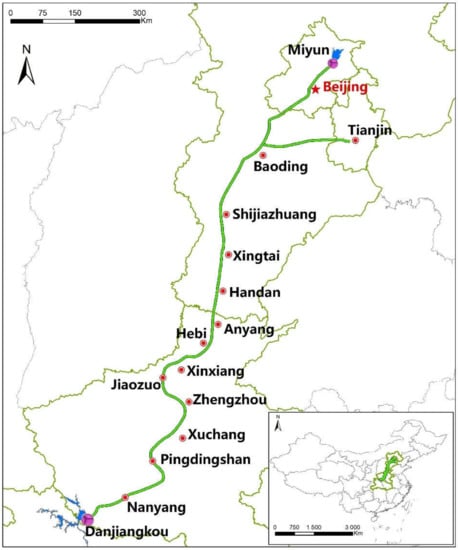
Figure 2.
The middle route of the South-to-North Water Diversion project.
This study considered the TN as a representative water quality index, and 2016 was considered as a study year because the data were complete and the project operation and management were relatively mature. Focusing on the question of “whether clean water from the Danjiangkou Reservoir will be polluted by atmospheric deposition,” the study modeled the atmospheric deposition’s effects on the diversion water quality, and the implementation process is shown in Figure 3.
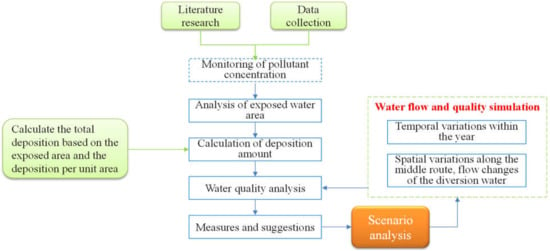
Figure 3.
Implementation process of the study.
3. Methods
The atmospheric deposition model and the water flow and quality models of the middle route and Miyun Reservoir were developed in this study. The atmospheric deposition simulation was used to determine the deposition rate of pollutants, and the water flow and quality simulation was used to analyze the dynamic changes of pollutants’ concentration in the MR-SNWDP and Miyun Reservoir under atmospheric deposition.
3.1. Atmospheric Deposition Model
The atmospheric deposition model includes two parts: dry and wet deposition.
3.1.1. Dry Deposition
Atmospheric pollutants’ dry deposition varies greatly with atmospheric conditions, pollutant types, and underlying surface types. Assuming that the pollutants’ deposition rate is inversely proportional to the resistance encountered during the deposition process, the calculation equation is as follows:
where , , and represent parameters of aerodynamic resistance, adhesive layer resistance, and land surface resistance, respectively [20]. The three parameters are related to the wind speed and air humidity, and they can be estimated by the field experiments [21].
3.1.2. Wet Deposition
The wet deposition process includes precipitation and pollutant deposition. The precipitation recharge was converted into rainfall intensity (mm/s) from the 24 h rainfall (mm), and the wet deposition was estimated by empirical Equation (2) as follows:
where represents the wet deposition; is the pollutants’ concentration; is the rainfall intensity; and is the pollutants’ flushing coefficient, which can also be estimated by the field experiments [2].
3.2. Water Flow and Quality Model of the Middle Route
3.2.1. Water Flow Model
The middle route diversion flow was simulated with the one-dimensional unsteady Saint–Venant equations (Equations (3) and (4)). The water flow continuity Equation (3) can be derived assuming that water is incompressible, while the momentum Equation (4) is derived from the momentum conservation under the action of gravity, water pressure, frictional drag, and inertial force. The equations were solved by the difference method of the four-point implicit scheme, Preimann scheme [22].
where is the longitudinal distance ; is the time period ; is the cross-sectional water area (m2); is the cross-sectional flow discharge is the average flow velocity of a cross-section ; is the inflow of the tributary and is also the input item of rainfall falling into the river under wet deposition ; is the water level ; is the acceleration of gravity, ; is the Manning roughness coefficient; and is the hydraulic radius .
In addition, there are many hydraulic constructions along the MR-SNWDP, including control gates, water diversion gates, aqueducts, and inverted siphons. The model treats various types of buildings as internal boundary conditions [23]. For example, the internal boundary equations of the control gate are shown in Equations (5) and (6).
where is the serial number of the cross-section where the control gate is located; and represent the flow before and after the control gate, respectively ; and represent the water level before and after the control gate, respectively ; is the side shrinkage coefficient of the gate; is the submerged coefficient; is the flow coefficient; is the gate width ; and is the gate opening .
3.2.2. Water Quality Model
Generally, the pollutants’ migration and diffusion in rivers are complex three-dimensional unsteady problems. They are not only related to water flow state, but also affected by meteorological factors such as water temperature and wind speed. As the difference of pollutants’ concentration between horizontal and vertical directions is very slight when compared with that in the longitudinal direction, the pollutants can be approximately simulated with the one-dimensional convection and diffusion equation. Considering the first-order reaction of pollutants in diversion water, the water quality is simulated by Equation (7), which is also solved using the difference method [22].
where is the concentration of pollutants ; is the longitudinal diffusion coefficient including dispersion ; is the first-order reaction coefficient , which generally takes a value between 0.02 and 0.3 for TN [24,25]; and is a source–sink term (, which includes the atmospheric deposition.
3.3. Water Flow and Quality Model of the Miyun Reservoir
3.3.1. Water Flow Model
The hydrodynamic module of the EFDC model was used for flow simulation, listed as follows [26]:
Momentum equation:
Continuity equation:
where and are orthogonal curvilinear coordinates; , , , and represent the partial derivative of variables with respect to time and space; is the vertical coordinate; and are the velocity variables in the and directions, respectively ; , , and are transform coefficients; is the dimensionless vertical velocity in the direction of the coordinate; pressure is obtained by subtracting the static pressure, , corresponding to the reference density from the total pressure and dividing by the reference density (; is the water depth ; is the Coriolis force parameter and is the intermediate variable; is the vertical turbulent diffusion coefficient ; and are the source and sink terms of the momentum equation, respectively (including horizontal diffusion terms, etc. ; and represents other point and nonpoint inflows, such as evaporation, rainfall, and groundwater exchange.
3.3.2. Water Quality Model
The water quality module of the EFDC model was used for water quality simulation, listed as follows [27]:
where , , and represent the diffusion coefficient in the , , and directions, respectively .
The EFDC model can simulate 21 water quality indicators, including algae, organic carbon, phosphorus, nitrogen, and silicon. The conditions required for model simulation are divided into boundary conditions and initial conditions. The boundary conditions include inflow and outflow boundaries, as well as atmospheric boundaries, such as air pressure, temperature, humidity, precipitation, evaporation, radiation, and wind speed. The initial conditions include initial water level and temperature, bottom bed temperature, and state variables of water quality.
4. Results
The water flow and quality models were used to simulate the effects of atmospheric deposition on the water quality of diversion water to Beijing by the MR-SNWDP.
4.1. Water Quality Analysis of the Middle Route under Atmospheric Deposition
The multi-year monthly average data of TN deposition rates along the middle route were collected, and parts of regions are shown in Figure 4. It can be observed that the atmospheric deposition varies significantly over time, and the value in summer is much smaller than that in winter. Figure 4 also shows that the variations in nitrogen deposition rate along the MR-SNWDP were highly consistent.
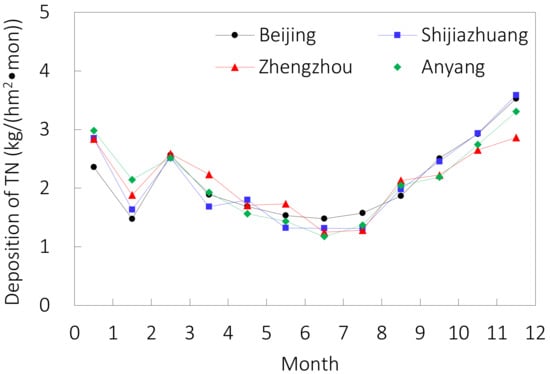
Figure 4.
Multi-year monthly average atmospheric nitrogen deposition in parts of regions along the MR-SNWDP.
In addition, the time series of TN concentration and diversion flow discharge at the head cross-section of Taocha were obtained and are shown in Figure 5.
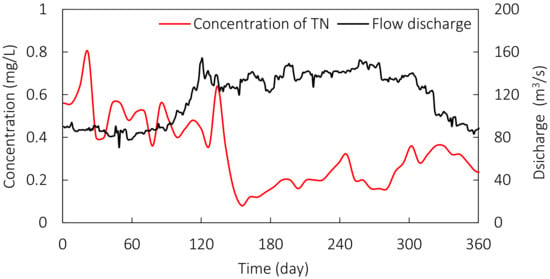
Figure 5.
Flow discharge and concentration of TN at the inlet of the middle route.
As seen in Figure 5, both the diversion water flow and its water quality were not uniform within a year. The concentration in summer was smaller than that in spring, which was in accordance with the atmospheric deposition. After the nitrogen deposition rate was determined, the time-variation of TN concentration at the outlet of the middle route was simulated, as shown in Figure 6.
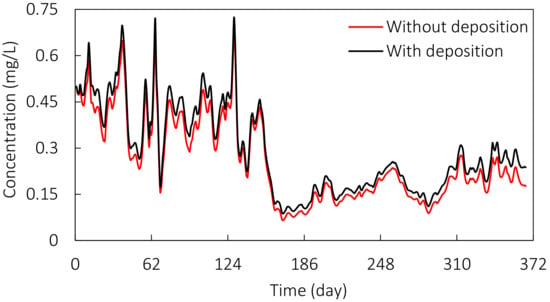
Figure 6.
The simulated concentration of TN at the outlet of the middle route.
Figure 6 indicates that the atmospheric deposition can significantly increase the simulated TN concentration with the deterioration in water quality. This deterioration was obvious in March, April, November, and December, and it appeared to be relatively slight in summer and autumn, which was related to the intensity of atmospheric deposition in different time periods. Combining Figure 4 and Figure 5, it can also be found that increasing the flow discharge and reducing nitrogen concentration at the head cross-section is helpful to mitigate the effects of atmospheric deposition.
In addition, the water quality classification measured by TN at the outlet of the middle route was carried out and is listed in Table 1. The results were referred to the Chinese “Environmental quality standards for surface water” (GB 3838-2002).

Table 1.
Water quality classification at the outlet of the middle route in 2016.
With the atmospheric deposition considered, the number of days with Class I of water quality decreased by about 20%, but the number corresponding to Class III doubled. Under atmospheric deposition, at least 50 days in 2016 turned into a lower level of water quality classification. Therefore, atmospheric deposition has a significant effect on the water quality of the MR-SNWDP, such that the clean water transferred through the middle route to Beijing faces pollution risks from atmospheric deposition.
4.2. Water Quality Analysis in the Miyun Reservoir under Atmospheric Deposition
With the diversion water from the MR-SNWDP stored in the Miyun Reservoir, its water quality should also be investigated. Four points (Kuxi, Kudong, Jingou, and the dam of Chaohe) in the reservoir area were selected to analyze its water quality results, as shown in Figure 7.
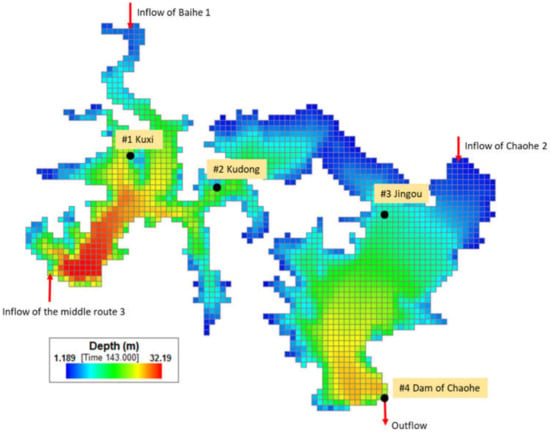
Figure 7.
Location of the water quality observing points in Miyun Reservoir.
Considering the influence of atmospheric deposition on the diversion water of the MR-SNWDP, the water quality results at the above four points of the Miyun Reservoir are compared in Figure 8.

Figure 8.
The simulated concentration of TN at four observing points in Miyun Reservoir: (a) Kuxi, (b) Kudong, (c) Jingou, and (d) Dam of Chaohe.
According to Figure 8, the atmospheric deposition had slight effects on the water quality of the Miyun Reservoir, where the simulation results are consistent with the existing conclusions in the relevant literature [28,29]. Obviously, the effects of atmospheric deposition on the water quality of the middle route (Figure 6) and the Miyun Reservoir showed different variation rules. Moreover, the clear water from the MR-SNWMP would significantly deteriorate after storage in the Miyun Reservoir as the TN concentration increased significantly. Therefore, it is necessary to analyze the reasonable regulation scheme of the Miyun Reservoir so that the atmospheric deposition will affect the diversion water to Beijing as little as possible.
Further, within the reservoir area, there were some differences among the concentration processes at the four observing points. Particularly, the difference in concentration processes between the dam of Chaohe and the other three points was the most obvious, indicating that the pollutants had been redistributed after they entered the reservoir.
5. Discussion
Based upon the results in 2016, several water diversion schemes of the middle route and water regulation schemes of the Miyun Reservoir were discussed, as shown in Table 2. This allowed the water quality variations at the outlet of the middle route and in the Miyun Reservoir to be analyzed under different scenarios.

Table 2.
Scenarios of water diversion schemes.
Table 2 shows two water diversion schemes of the middle route and three water regulation schemes of the Miyun Reservoir: (i) The middle route used 2016 as the scenario year, and allocated water to various provinces and cities according to the proportion set in the water transfer plan (which transfers 3.77 billion m3 of water to Henan, 3.49 billion m3 to Hebei, 1.24 billion m3 to Beijing, and 1 billion m3 to Tianjin). The allocation ratio was set to 40:35:15:10. (ii) The Miyun Reservoir used the 2016 observation data. (iii) Atmospheric deposition adopted the multi-year average values (Figure 4). The scenarios results were obtained and are shown in Figure 9 and Table 3.
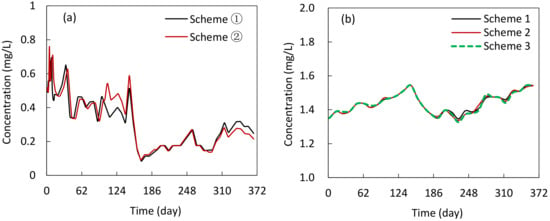
Figure 9.
Results of different water diversion schemes: (a) concentration of TN at the outlet of the middle route; (b) concentration of TN at the dam of Chaohe under water diversion scheme ①.

Table 3.
Water quality results of different schemes in 2016 under atmospheric deposition.
According to Figure 9a and Table 3, atmospheric deposition affected the middle route more significantly after the diversion water flow increased. Both the number of days with Class III of water quality and the peak TN concentration increased when the water diversion scheme changed from Scheme ① to ②. The results showed that it is more advantageous to adopt a constant water diversion scheme in the middle route. For the Miyun Reservoir in Figure 9b and Table 3, the effects of atmospheric deposition on its water quality were almost unassociated with the regulated water. Again, after storage in the reservoir, the concentration of transferred water increased significantly from a lower initial value and the water quality level degraded to Class IV or even Class V. The results demonstrated that the Miyun Reservoir should focus on the storage amounts of the transferred water in the reservoir when regulating water from the middle route.
Obviously, the atmospheric deposition is related to the diversion water amounts of the MR-SNWDP. Therefore, different diversion flow scenarios were compared in Table 4 to further reveal the influence of flow discharge.

Table 4.
The water quality classification at the outlet of the middle route in different water diversion schemes.
With the diversion water flow increased from 50 m3/s to 150 m3/s, the water quality at the outlet of the middle route gradually deteriorated. Nevertheless, this influence from diversion flow became very little when the discharge reached 200 m3/s. The results in Table 4 also support water diversion scheme ① in Table 2.
6. Conclusions
This study focused on the question of “whether the clean water entering Beijing from the MR-SNWDP will be polluted by atmospheric deposition” and modeled the effects of atmospheric deposition on the diversion water quality using the water flow and quality models. The main finding was that atmospheric deposition needs to be considered in the decision-making about the allocation of transferred water to Beijing. The specific conclusions of this study are as follows: (1) Atmospheric deposition had a nonnegligible effect on the water quality of the MR-SNWDP. After atmospheric deposition was considered, the water quality of the middle route significantly deteriorated. (2) The influence of atmospheric deposition on water quality was related to the diversion water flow in the middle route, and this influence became little when the flow reached 200 m3/s. (3) The effects of the atmospheric deposition between the middle route and the Miyun Reservoir were very different. Adopting a constant water diversion scheme throughout the year helps reduce the effects of atmospheric deposition in the middle route, while the effects in the Miyun Reservoir is almost unassociated with the regulated water amounts. However, the storage amounts of diversion water in the Miyun Reservoir should be as low as possible.
There are still several aspects to be improved in this research, including the model verification of simulation results based upon the real water resources allocation work in Beijing, and the atmospheric deposition analysis in more time periods, particularly for consecutive years.
Author Contributions
Conceptualization, J.Z.; methodology, J.W. and S.C.; software, J.W. and S.C.; validation, J.W. and S.C.; formal analysis, J.W. and S.C.; resources, S.C.; data curation, S.C.; writing—original draft preparation, J.W.; writing—review and editing, S.C. and J.Z.; visualization, J.W. and S.C.; supervision, J.Z.; funding acquisition, J.W. and J.Z. All authors have read and agreed to the published version of the manuscript.
Funding
This work was supported by the Joint Open Research Fund Program of State Key Laboratory of Hydroscience and Engineering and Tsinghua—Ningxia Yinchuan Joint Institute of Internet of Waters on Digital Water Governance (sklhse-2021-Iow01); the Guangdong Basic and Applied Basic Research Foundation (2020A1515110906).
Acknowledgments
We thank the editors and the three anonymous reviewers for their insightful comments and excellent suggestions, which are very helpful for the improvements of this paper.
Conflicts of Interest
The authors declare no conflict of interest.
References
- Liu, W.Z.; Wang, X.Y.; Fan, Y.B. A review of atmospheric nitrogen deposition and its estimated contributions to nitrogen input of waters. Environ. Pollut. Control 2014, 36, 88–93, 101. (In Chinese) [Google Scholar] [CrossRef]
- Pan, Y.P.; Wang, Y.S.; Tang, G.Q.; Wu, D. Wet and dry deposition of atmospheric nitrogen at ten sites in Northern China. Atmos. Chem. Phys. 2012, 12, 6515–6535. [Google Scholar] [CrossRef] [Green Version]
- Wesely, M.L.; Hicks, B.B. A review of the current status of knowledge on dry deposition. Atmos. Environ. 2000, 34, 2261–2282. [Google Scholar] [CrossRef]
- Gao, Y.; Jia, Y.; Yu, G.; He, N.; Zhang, L.; Zhu, B.; Wang, Y. Anthropogenic reactive nitrogen deposition and associated nutrient limitation effect on gross primary productivity in inland water of China. J. Clean. Prod. 2019, 208, 530–540. [Google Scholar] [CrossRef]
- Liu, X.; Zhang, Y.; Han, W.; Tang, A.; Shen, J.; Cui, J.; Vitousek, P.; Erisman, J.W.; Goulding, K.W.T.; Christie, P.; et al. Enhanced nitrogen deposition over China. Nature 2013, 494, 459–462. [Google Scholar] [CrossRef]
- Liu, X.; Xu, W.; Sha, Z.; Zhang, Y.; Wen, Z.; Wang, J.; Zhang, F.; Goulding, K.W.T. A green eco-environment for sustainable development—Framework and action. Front. Agric. Sci. Eng. 2020, 7, 67–74. [Google Scholar] [CrossRef] [Green Version]
- Pan, Y.P.; Wang, Y.S.; Tang, G.Q.; Wu, D. Spatial distribution and temporal variations of atmospheric sulfur deposition in northern china: Insights into the potential acidification risks. Atmos. Chem. Phys. 2013, 13, 1675–1688. [Google Scholar] [CrossRef] [Green Version]
- Wang, Z.; Zhang, X.; Liu, L.; Cheng, M.; Xu, J. Spatial and seasonal patterns of atmospheric nitrogen deposition in North China. Atmos. Ocean. Sci. Lett. 2020, 13, 188–194. [Google Scholar] [CrossRef]
- Yu, G.; Jia, Y.; He, N.; Zhu, J.; Chen, Z.; Wang, Q.; Piao, S.; Liu, X.; He, H.; Guo, X.; et al. Stabilization of atmospheric nitrogen deposition in China over the past decade. Nat. Geosci. 2019, 12, 424–429. [Google Scholar] [CrossRef]
- Wen, Z.; Xu, W.; Li, Q.; Han, M.; Tang, A.; Zhang, Y.; Luo, X.; Shen, J.; Wang, W.; Li, K.; et al. Changes of nitrogen deposition in China from 1980 to 2018. Environ. Int. 2020, 144, 106022. [Google Scholar] [CrossRef]
- Liu, X.; Du, E. An overview of atmospheric reactive nitrogen in China from a global perspective. In Atmospheric Reactive Nitrogen in China; Springer: Singapore, 2020; pp. 1–10. [Google Scholar] [CrossRef]
- Song, H.H.; Jiang, C.M.; Yu, W.T. Basic features and monitoring methodologies of atmospheric nitrogen deposition. Chin. J. Appl. Ecol. 2014, 25, 599–610. (In Chinese) [Google Scholar] [CrossRef]
- Sabin, L.D.; Lim, J.H.; Stolzenbach, K.D.; Schiff, K.C. Contribution of trace metals from atmospheric deposition to stormwater runoff in a small impervious urban catchment. Water Res. 2005, 39, 3929–3937. [Google Scholar] [CrossRef] [PubMed]
- Yu, H.; Zhang, L.; Yan, S.; Li, H.; Xu, J. Atmospheric wet deposition characteristics of nitrogen and phosphorus nutrients in Taihu lake and contributions to the lake. Res. Environ. Sci. 2011, 24, 1210–1219. (In Chinese) [Google Scholar] [CrossRef]
- Pan, Y.P.; Zhu, X.Y.; Tian, S.L.; Wang, L.L.; Zhang, G.Z.; Zhou, Y.B.; Xu, P.; Hu, B.; Wang, Y.S. Wet deposition and scavenging ratio of air pollutants during an extreme rainstorm in the North China Plain. Atmos. Ocean. Sci. Lett. 2017, 10, 348–353. [Google Scholar] [CrossRef] [Green Version]
- Wu, Q.; Cui, S.B.; Luo, H.; Xu, L.Q. Numerical simulation of the contribution of wet atmospheric deposition to the eutrophication of river reservoir for water supply. Pearl River 2014, 35, 8–11. (In Chinese) [Google Scholar] [CrossRef]
- Yang, D.; Xu, X.; Liu, X.; Ding, G.; Xu, Q.; Cheng, X.; Chen, H.; Zhou, H.; Wang, Z.; Wang, W. Integrated sources of air-soil-water pollution in Miyun Reservoir. Sci. China Ser. D Earth Sci. 2005, 35 (Suppl. 1), 195–205. (In Chinese) [Google Scholar] [CrossRef]
- Pitois, S.; Jackson, M.H.; Wood, B.J. Sources of the Eutrophication. J. Environ. Health 2001, 64, 25–32. [Google Scholar]
- Ni, G.; Chen, T.; Zhang, T.; Tian, F.; Xie, Z.; Ma, D.; Han, Z.; Sun, F. Research on critical technologies of joint allocation and regulation of multiple sources of water resources considering the South-to-North Water Diversion. China Water Resour. 2012, S1, 56–58. (In Chinese) [Google Scholar]
- Giardina, M.; Buffa, P. A new approach for modeling dry deposition velocity of particles. Atmos. Environ. 2018, 180, 11–22. [Google Scholar] [CrossRef]
- Figgis, B.; Guo, B.; Javed, W.; Ahzi, S.; Rémond, Y. Dominant environmental parameters for dust deposition and resuspension in desert climates. Aerosol Sci. Technol. 2018, 52, 788–798. [Google Scholar] [CrossRef] [Green Version]
- Wang, J.; Zhao, J.; Lei, X.; Wang, H. New approach for point pollution source identification in rivers based on the backward probability method. Environ. Pollut. 2018, 241, 759–774. [Google Scholar] [CrossRef] [PubMed]
- Lei, X.; Zheng, H.; Shang, Y.; Wang, H. Assessing emergency regulation technology in the middle route of the South-to-North Water Diversion Project, China. Int. J. Water Resour. Dev. 2018, 34, 405–417. [Google Scholar] [CrossRef]
- Guo, R.; Li, Y.B.; Fu, G. Controlling factors of degradation coefficient on organic pollutant in river. J. Meteorol. Environ. 2008, 01, 56–59. (In Chinese) [Google Scholar] [CrossRef]
- Pan, X.; Tang, L.; Feng, J.; Liang, R.; Pu, X.; Li, R.; Li, K. Experimental Research on the Degradation Coefficient of Ammonia Nitrogen Under Different Hydrodynamic Conditions. Bull. Environ. Contam. Toxicol. 2020, 104, 288–292. [Google Scholar] [CrossRef] [PubMed]
- Hamrick, J.M.; Mills, W.B. Analysis of water temperatures in Conowingo Pond as influenced by the peach bottom atomic power plant thermal discharge. Environ. Sci. Policy 2000, 3 (Suppl. 1), 197–209. [Google Scholar] [CrossRef]
- Park, K.; Jung, H.S.; Kim, H.S.; Ahn, S.M. Three-dimensional Hydrodynamic Eutrophication Model (HEM-3D): Application to Kwang-Yang Bay, Korea. Mar. Environ. Res. 2004, 60, 171–193. [Google Scholar] [CrossRef]
- Li, D.Q.; Guo, X.; Liang, J.; Zhao, W.; Zhang, L. Multivariate statistical analysis on spatial variations of water quality of Miyun Reservoir. Wetl. Sci. 2015, 13, 27–34. [Google Scholar] [CrossRef]
- Wang, Y.; Jiang, Y.; Liao, W.; Gao, P.; Huang, X.; Wang, H.; Song, X.; Lei, X. 3-D hydro-environmental simulation of Miyun reservoir, Beijing. J. Hydro-Environ. Res. 2013, 8, 383–395. [Google Scholar] [CrossRef]
Publisher’s Note: MDPI stays neutral with regard to jurisdictional claims in published maps and institutional affiliations. |
© 2022 by the authors. Licensee MDPI, Basel, Switzerland. This article is an open access article distributed under the terms and conditions of the Creative Commons Attribution (CC BY) license (https://creativecommons.org/licenses/by/4.0/).